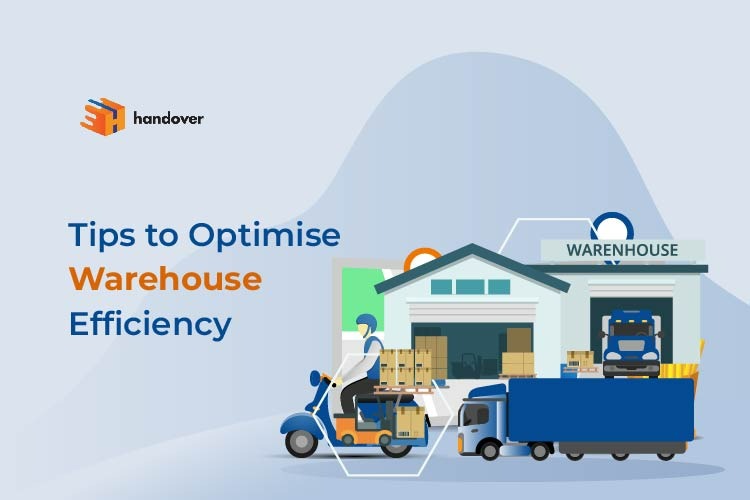Handover news
Blog
Tips to Optimise Warehouse Efficiency

Warehouse performance plays an important role in smooth logistics operations. It helps in customer satisfaction, inventory management, controlling operational costs, etc. So, it is crucial for businesses to manage them perfectly in order to maintain their business successfully. But as businesses, you need to measure and improve them. The following are some of the best practices to help you optimise your warehouse processes and systems.
What is Warehouse Optimisation?
Using time, space and resources to increase a warehouse’s efficiency is known as warehouse optimisation. The technique aims to increase customer satisfaction and improve the overall customer experience by using automation and careful planning.
Fully optimised warehouses are flexible and quick enough to outperform their competition. Additionally, optimised warehouses can run at higher profit margins and are safer for people involved in warehouse management.
The key to warehouse optimisation is automation. Other things to look at are:
- Improved Communication
- Warehouse Flow
- Product Placement
- Storage Systems
- Retrieval Practices
Following the same will help you carry out efficient delivery services in Ghaziabad, Noida, Delhi, Mumbai, Pune, Bangalore, Chennai and various other places.
What are the Challenges of Warehouse Optimisation?
Like every other thing, there can be challenges to warehouse optimisation. The following are some of the challenges that businesses experience in warehouse optimisation.
Inventory Management
Without an improved automated system, it is always difficult to know exactly how much product you have in stock and how much you have on order. When going manually, you can anytime miscalculate the availability of products and miss the opportunity of delivering the same to the customers.
Inventory Location
Businesses often get confused about where exactly they keep the products in the warehouse. They need to know precisely where their product is located within the warehouse and how it can be loaded and sent via delivery personnel to the final destination. So, it is important to precisely know the exact location of your products.
Space Optimisation
In an optimised warehouse, businesses use their space for stocking large numbers of products. This means the warehouse can be used at full capacity by storing the right product at the right place. Once businesses use space carefully, they can easily deliver products at the right time.
Picking Optimisation
An optimised warehouse has common routes for picking products for deliveries. For this, they need trained and skilled delivery executives in safe picking practices. They can do delivery jobs in Noida, Delhi, Ghaziabad, Mumbai, Bangalore or wherever you want.
Best Warehouse Optimisation Practices
Use the Right Equipment for Warehouse
It’s amazing to see the current developments in robotics that enable warehouse management systems flawless. However, not every operation benefits from every piece of technology.
In reality, before applying automation, your current warehouse structure needs to be upgraded. Additionally, be ready for warehouse management systems that regulate your order fulfilment and distribution processes.
Firstly, start with flexible solutions that can work with the current infrastructure. You can thus make adjustments to the timeline that suits your business.
Automate Your Data Collection Methods.
A seamless warehouse produces a vast amount of data. And there are many choices regarding automated data gathering and transfer.
Manual data collection takes more time and is more tedious than automated data collection. Additionally, automated data collection reduces the possibility of human mistake, speeds up the process of collecting results, and smoothly integrates data from all areas of your operation.
For instance, you can use data from many sources to track customers’ delivery preferences and acquire supply chain insights through automated data analysis.
Evaluate Inventory
You need to choose an inventory management software system that helps you monitor inventory carefully and closely and provides you with an accurate record of products to be delivered or stored in a warehouse. Evaluating your inventory allows you to keep trending products available in the warehouse. It can also help you easily avoid products that lack demand.
Offer a Streamline Product Return Process
In online business, there are lots of customers who return their products due to several reasons once they purchase them. This means that the management of returns is an important part of your warehouse operations.
For this, you need to use software solutions that offer integrated returns processing functions, making your customers satisfied. With this software, you can store and track your returns and easily see the reasons why products are returned.
Conclusion
Optimising a warehouse is crucial for your business. Because it is an important aspect that enables your business to run seamlessly. It includes various tasks ranging from evaluating inventory, automating data collection to managing a product return process. As a business owner, if you seek a partner for seamless goods transportation from one place to another, contact handover. It’s a low-cost logistics service provider with an extensive range of delivery fleet including 2-wheelers, 3-wheelers, 4-wheelers, and electric vehicles (EVs).
